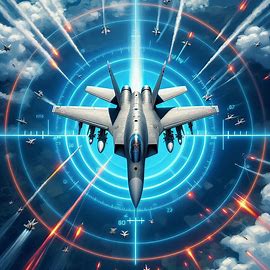
Introduction
In modern aerial warfare, the ability of fighter jets to detect, track, and lock on to enemy targets is crucial for mission success. Locking on enables pilots to launch precision-guided weapons and defend against threats effectively. This process involves sophisticated sensor systems, radar technologies, and pilot expertise, all working together seamlessly under intense combat conditions.
This article breaks down how fighter jets lock on to enemy targets, covering the technology behind it, operational tactics, and future developments.
1. The Basics of Target Lock-On
1.1 What Does Lock-On Mean?
Lock-on refers to the state where a fighter jet’s targeting system has successfully identified and is continuously tracking an enemy aircraft or missile, enabling weapon systems to engage accurately.
When a lock is established, the pilot’s avionics maintain a continuous data link with the target’s position and movement, crucial for missile guidance and firing decisions.
1.2 Why Lock-On Is Critical
-
Ensures missiles receive accurate guidance during flight
-
Enhances pilot situational awareness
-
Allows engagement at varying distances (short or beyond visual range)
Lock-on can be achieved using radar or infrared systems depending on the mission profile and type of weaponry employed.
2. Radar Systems in Fighter Jets
2.1 Types of Radar Used for Locking On
Radar remains the primary sensor for detecting and locking on to distant targets. The main radar types include:
-
Pulse-Doppler Radar: Detects moving targets while filtering out ground clutter.
-
Active Electronically Scanned Array (AESA): Advanced radars that rapidly scan the sky electronically without moving parts, offering improved accuracy and stealth capabilities.
2.2 Radar Lock-On Process
-
Search Mode: Radar scans for potential targets using a broad beam.
-
Track-While-Scan (TWS): Once a target is detected, the radar tracks multiple targets simultaneously, updating their positions in real time.
-
Single Target Track (STT): Radar locks on one target for missile guidance, providing continuous tracking data.
2.3 Radar-Guided Missile Lock
Active radar-guided missiles like the AIM-120 AMRAAM rely on radar lock-on for mid-course and terminal guidance, receiving updates from the launching aircraft until their own seeker takes over.
3. Infrared (IR) Targeting and Lock-On
3.1 How IR Lock Works
Infrared sensors detect the heat signatures emitted by enemy aircraft engines. These systems are especially effective for short-range engagements and in stealthy attack scenarios.
3.2 IR Targeting Systems
-
Helmet-Mounted Displays (HMDs): Allow pilots to lock onto targets by simply looking at them.
-
Infrared Search and Track (IRST): Passive sensors that detect and track heat sources without emitting signals, providing stealthy target acquisition.
3.3 Advantages and Limitations of IR Lock
-
Advantages: Passive tracking, hard to detect, excellent for dogfights.
-
Limitations: Reduced effectiveness in bad weather or against aircraft using cooling or countermeasures.
4. Multi-Sensor Fusion and Targeting Systems
4.1 Sensor Fusion Technology
Modern fighter jets integrate data from radar, IRST, electronic warfare sensors, and even external sources like AWACS to create a comprehensive battlespace picture.
4.2 Data Link and Network-Centric Warfare
Sharing targeting information between aircraft and command centers enhances lock-on capabilities and allows coordinated attacks.
4.3 Pilot Interface and Targeting Computers
Advanced cockpit displays and computers assist pilots in target selection, prioritization, and weapon employment, reducing workload and increasing accuracy.
5. Pilot Training and Tactical Considerations
5.1 Training for Effective Lock-On
Pilots undergo rigorous simulation and live training to master the timing and techniques of acquiring and maintaining target lock, especially under electronic countermeasures.
5.2 Countermeasures and Lock-On Evasion
Enemy tactics and technology, such as flares and jamming, challenge lock-on systems. Pilots must adapt and rely on multi-sensor data to maintain targeting.
5.3 Engagement Scenarios
-
Beyond Visual Range (BVR) Combat: Relies heavily on radar lock for missile launches.
-
Within Visual Range (WVR) Combat: Often uses IR lock and helmet-mounted targeting for rapid engagement.
Tables and Examples
| Lock-On System | Range | Guidance Type | Strengths | Weaknesses |
|---|---|---|---|---|
| Pulse-Doppler Radar | Long-range (>50km) | Radar tracking | Detects multiple targets; all-weather | Susceptible to jamming |
| AESA Radar | Long-range | Electronically scanned | High precision, stealthy operation | Complex and costly |
| Infrared Seekers | Short-range (<20km) | Heat tracking | Passive, effective in dogfights | Affected by weather, countermeasures |
| IRST | Medium-range | Passive IR tracking | Stealthy detection, no emissions | Limited in poor visibility |
Conclusion: The Art and Science of Locking On
Locking on to enemy targets is a blend of cutting-edge technology and skilled pilot execution. From radar pulses scanning the skies to the infrared glow of jet engines, these systems provide the edge in modern aerial combat.
How do you think future advances like AI and machine learning will further transform lock-on capabilities? Share your insights and join the conversation on the future of air combat targeting.